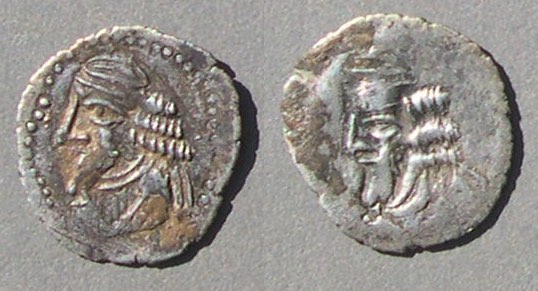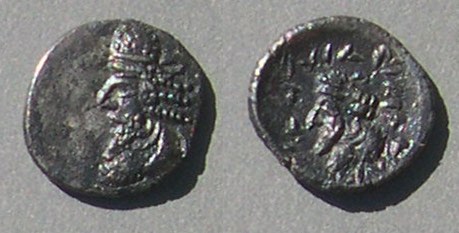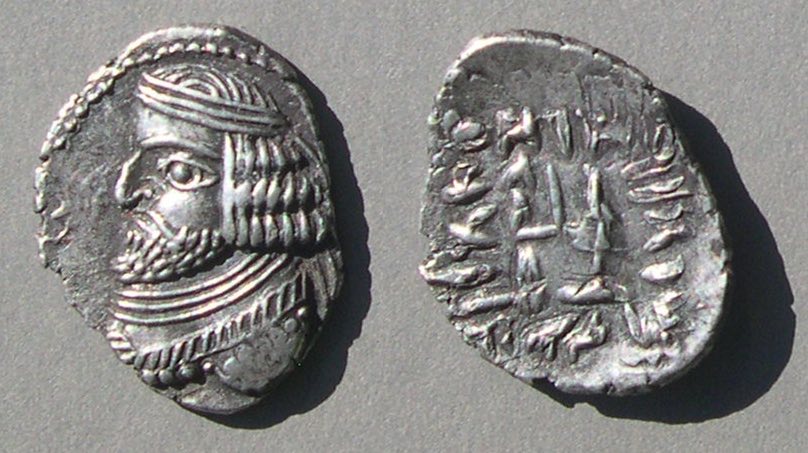 Ancient coins of Persis, a kingdom within Ancient Iran
Ancient coins of Persis, a kingdom within Ancient Iran
An educational page with selection of common types.
To the right: A silver drachm of King Vahsir (a.k.a. Oxathres), son of Darius II. First century BC.
22-17 mm. 4.01 grams.
Bust of king left.
Inscription in square around king on left standing and holding up a scepter(?) and facing an altar.
Where is Persis? Beginning under the Seleukids c. 280 BC, Persis was a dependent kingdom in southern Iran. (It is on the right side of this map for 74 BC from The Penguin Atlas of Ancient History by Colin McEvedy.) Its rather isolated territory was off the major trade routes.
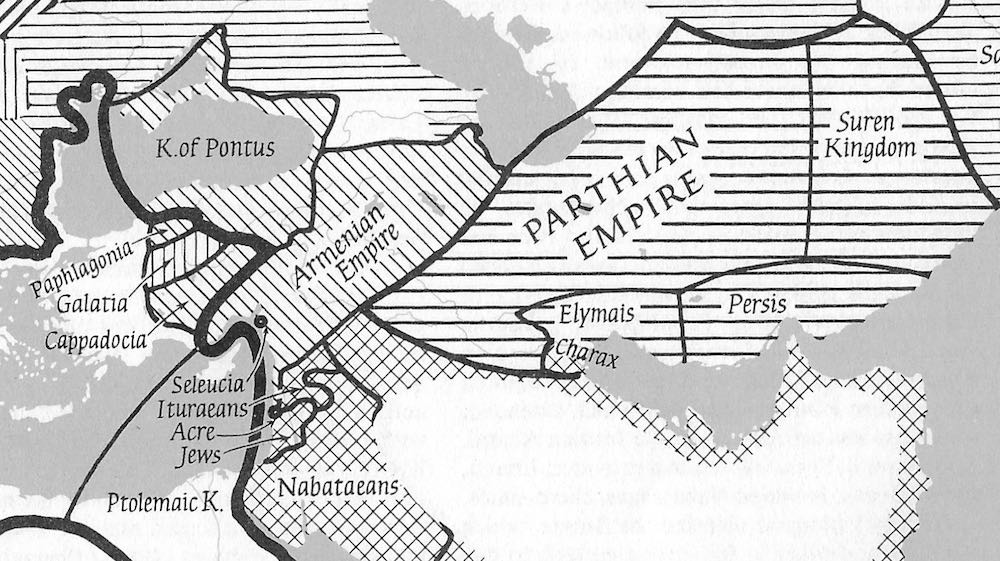 When the Parthians (Arsacids) took Iran from the Seleukids c. 250 BC, Persis remained dependent, but was able to issue its own coins. The last ruler of Persis, Ardaxšir (Artaxerxes) V, overthrew the Parthian rulers (Arsacids) c. 224 AD and became the first king of what we now call the Sasanians and then issued new larger silver coin types. For Sasanian coinage he is called Ardaxšir I, a.k.a. Ardashir I (instead of Ardaxšir V of Persis).
Coins of Persis. The collection illustrated below is representative of the most common issues of Persis. It has none of the rare early tetradrachms and none of the rare late coins from the transition to Sasanian types. The up-to-date reference is by P. A. van't Haaff (abbreviated "vH" many times below), Catalogue of Persis Coinage, Ca. 280 B.C. – A.D. 228. It is available for free in pdf from CNG.
When the Parthians (Arsacids) took Iran from the Seleukids c. 250 BC, Persis remained dependent, but was able to issue its own coins. The last ruler of Persis, Ardaxšir (Artaxerxes) V, overthrew the Parthian rulers (Arsacids) c. 224 AD and became the first king of what we now call the Sasanians and then issued new larger silver coin types. For Sasanian coinage he is called Ardaxšir I, a.k.a. Ardashir I (instead of Ardaxšir V of Persis).
Coins of Persis. The collection illustrated below is representative of the most common issues of Persis. It has none of the rare early tetradrachms and none of the rare late coins from the transition to Sasanian types. The up-to-date reference is by P. A. van't Haaff (abbreviated "vH" many times below), Catalogue of Persis Coinage, Ca. 280 B.C. – A.D. 228. It is available for free in pdf from CNG.
Coins illustrated on this page are not for sale, but I have some for sale on another page.
Except for the rare early tetradrachms, silver coins were issued in three denominations: drachms (usually somewhat less than 4 grams), hemidrachms, and obols (with six obols to a drachm). It is thought that the local value was set above the actual silver value, so the coins did not circulate outside the region of Persis [vH page 15]. Gold and copper coins were not issued. There is often only one design per king, the same design being repeated on each denomination. "Preparation of the flans was not careful" [vH, page 15]. Many flans are irregular in thickness and far from round.
Some coins of Persis
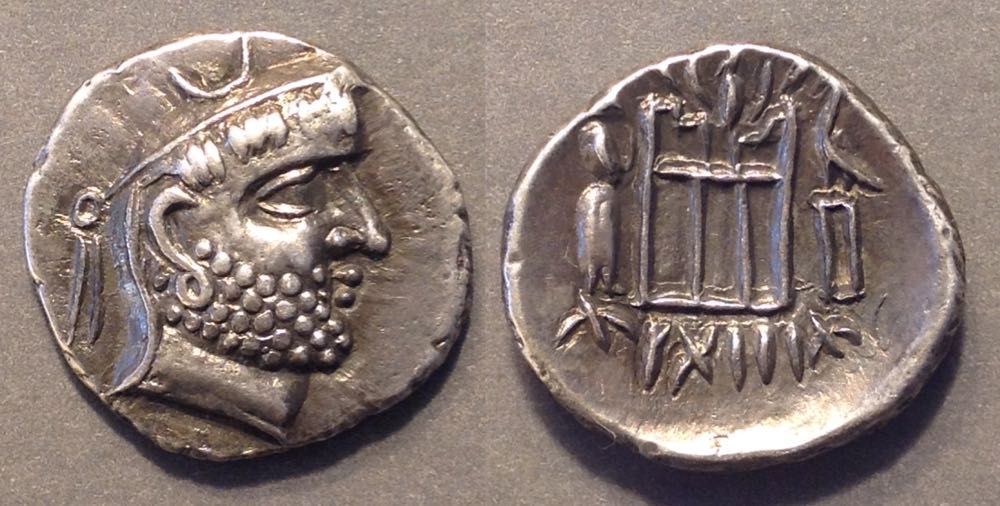 Darayan (Darius I of Persis). End of second century BC.
Darayan (Darius I of Persis). End of second century BC.
Names in bold are the names they used on their coins, transliterated from Aramaic. Names in parentheses are Greek versions of their names. Those older versions were used in books and catalogs and have been commonly used in books that discuss the region.
Drachm. 18 mm. 3.82 grams.
(Drachms of Persis are similar in size to Greek drachms and drachms of Parthia.)
The reverse shows an altar with the king to the left and a bird on a column to the right, with Aramaic lettering below.
vH 557 ("vH" abbreviates "van't Haaff" many times.)
(When vH ID numbers are integers without decimals, like this one, they are in Alram's book with that number.)
Names and Dates of Kings. "For most rulers more than one, sometimes even 3 or 4 names have been used in the numismatic literature. An example is Darayan, also known as Darev, Dareios or Darius" [vH page 2]. This site gives the names they used, transliterated, and often mentions (in parentheses) other names used in earlier numismatic literature. Diacritical marks have been omited here--thus "Ardaxšir" is written "Ardaxsir" ("Artaxerxes" is the older name).
A list of dynasties is below. The dates are contentious because there is little evidence other than the coins themselves. Van't Haaff discusses dates on pages 15ff and notes scholars disagreeing with each other by half a century.
Numbering. The type numbers are from van't Haaff's 2020 pdf, based on the type numbering in Alram’s 1986 book. Alram only included types with proper names and van't Haaff's book on coins of Persis is comprehensive and includes many types that do not have legends with proper names which therefore are not in Alram's book. If a type is in Alram, van't Haaff gave it Alram's number. If a type is not in Alram, and many are not, he modified the number of a related Alram type, sometimes yielding awkward results such as "572/575.1-2". The numbers range from 511 to 626. (In Alram's book, numbers lower than 511 and higher than 626 identify types from other kingdoms.) Van't Haaff's manuscript is in the process of revision and the next version will have an entirely new numbering system.
Reading the Legends. The legends are in Aramaic. "Poor minting techniques and serious barbarization of the legends in which often letters are missing or wrongly engraved makes reading of the legends difficult. The celators left letters or even whole words out when they had not created enough space for them. Reading the legends is not easy, because apart from the fact that the letters may be wrongly written (illiterate celators?), in Aramaic the B, D, R and K are similar and the vowels are not written" [vH page 13].
Types. "The Persis rulers up to the end of the 1st century AD were Zoroastrians, so symbols and images on Persis coinage from that period must be viewed in a Zoroastrian context. From the early 1st century AD onwards the Persis dynasts confessed to the Mithraic religion with Mithra as the main God" [vH, page 8]. Most reverses have the figure of the king at an altar, often with lettering around. Some have a smaller head on the reverse.

Unknown king I-X. Similar to Darius I of Persis. End of second century BC.
Obol. 9 mm. 0.69 grams.
vH 553
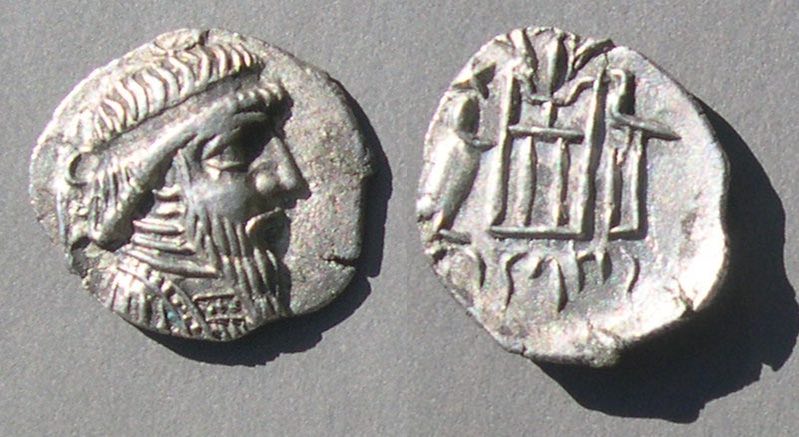
Vadfradad IV (Autophradates IV). 2nd century BC.
Drachm. 20-18 mm. 3.93 grams.
vH 561.1
(When vH ID numbers have decimals, like this one, they are a variant of a type in Alram's book.)

Vadfradad IV (Autophradates IV). 2nd century BC.
Obol. 9 mm. 0.60 grams.
vH 563
Coins of each denomination for Darayan II (Darius II)
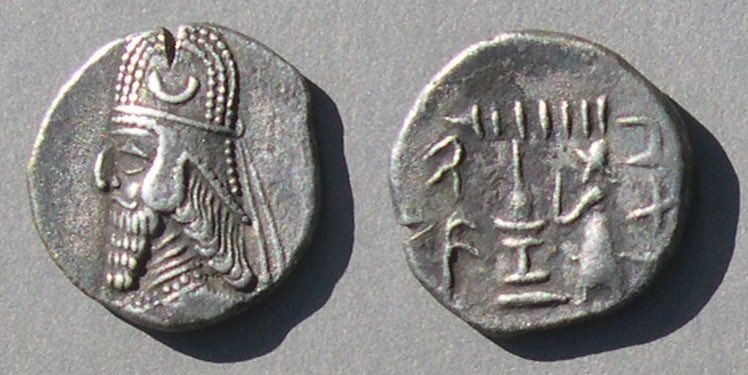
Darayan II (Darius II of Persis). 1st century BC.
Drachm. 17 mm. 3.57 grams.
vH 564.1-2.
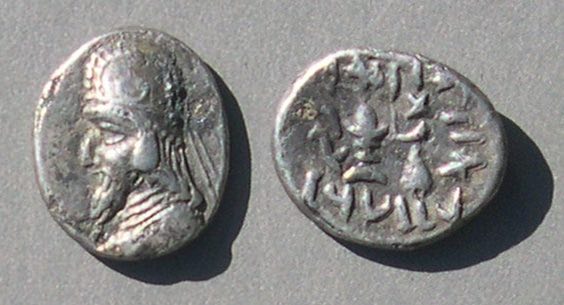
Darayan II (Darius II of Persis). 1st century BC.
Hemidrachm. 13-11 mm. 1.50 grams.
vH 565.2-2.
Darayan II (Darius II of Persis). 1st century BC.
Obol. 10-9 mm. 0.53 grams.
vH 566.1
Coins of each denomination for Ardaxsir II (Artaxerxes II)

Ardaxsir II (Artaxerxes II). Second half of first century BC.
Drachm. 21-10 mm. 3.94 grams.
vH 570

Ardaxsir II (Artaxerxes II). Second half of first century BC.
Hemidrachm. 15 mm. 1.90 grams.
vH 571/574.1-2.
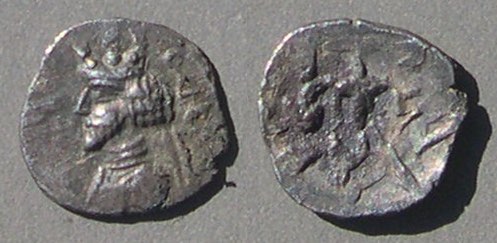
Ardaxsir II (Artaxerxes II). Second half of first century BC.
Obol. 11 mm. 0.53 grams.
vH 572/575.1-2.
Some of his coins have unusally broad and irregular flans:
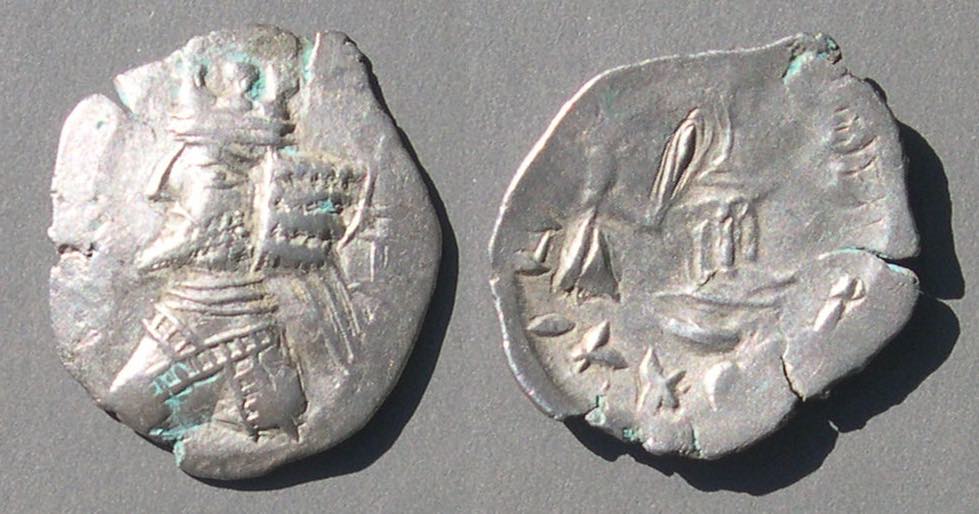
Ardaxsir II (Artaxerxes II). Second half of first century BC.
Drachm. 26-22 mm. 3.22 grams.
vH 576 but flan with larger diameter and lighter weight.
Coins of each denomination for Vahsir

[This is the first coin on the page, repeated.]
Vahsir (Oxathres), son of Darius II. First century BC.
Drachm. 22-17 mm. 4.01 grams. Bust of king left.
Inscription in square around king on left standing and holding up a scepter(?) and facing an altar.
vH 582/585
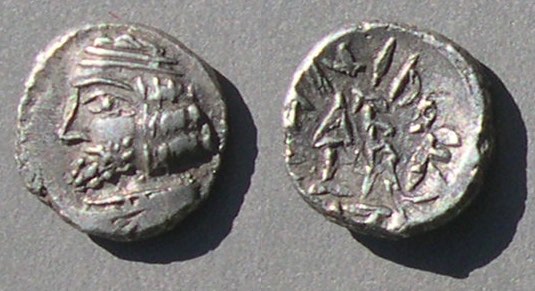
Vahsir (Oxathres), son of Darius II. First century BC.
Hemidrachm. 12 mm. 1.78 grams.
vH 580
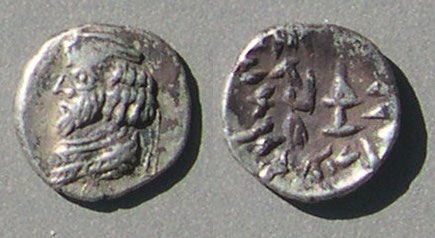
Vahsir (Oxathres), son of Darius II. First century BC.
Obol. 10 mm. 0.81 grams.
vH 584
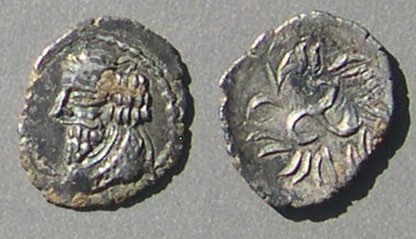
Pakor I. First half of the first century AD.
Obol. 11 mm. 0.36 grams.
vH 598
The meaning of the design with "triskeles turning left" is not known.
Coins of each denomination for Pakor II (formerly attributed to Pakor I)
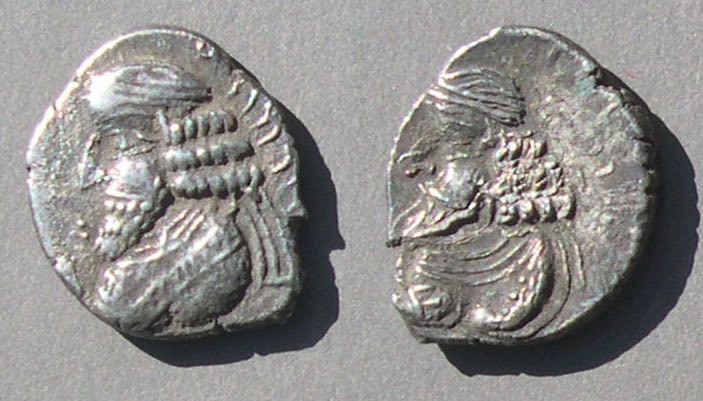
Pakor II. First half of the first century AD.
Drachm. 23-20 mm. 3.66 grams.
vH 588
Many coins of Peris have a bust on both sides. It is assumed the reigning king is on the obverse, but we do not know who is on the reverse. His son? Father? Himself again?
Pakor II. First half of the first century AD.
Hemidrachm. Thin. 20-18 mm. 1.73 grams.
vH 589
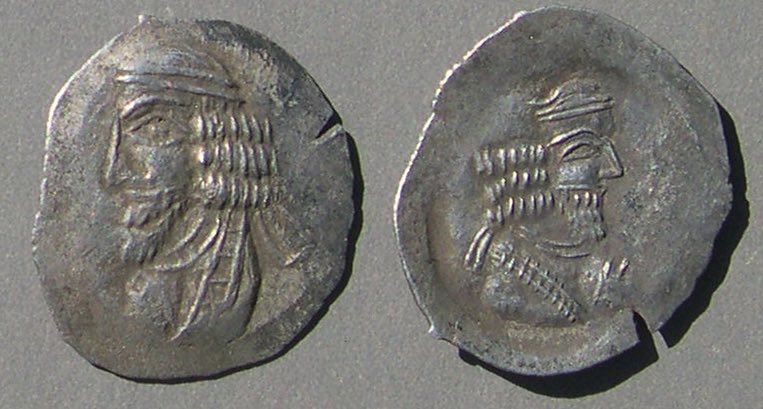
Pakor II. First half of the first century AD.
Hemidrachm. Thin. 21-19 mm. 1.52 grams.
Unusual right-facing reverse bust.
vH 591. Rare. No photo in vH.
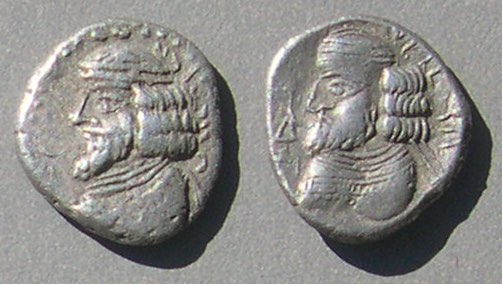
Pakor II. First half of the first century AD.
Hemidrachm. 12-11 mm. 1.67 grams. Much thicker than the above hemidrachms.
vH 593
Pakor II. First half of the first century AD.
Obol. 14-13 mm. 0.56 grams. Thin.
vH 590
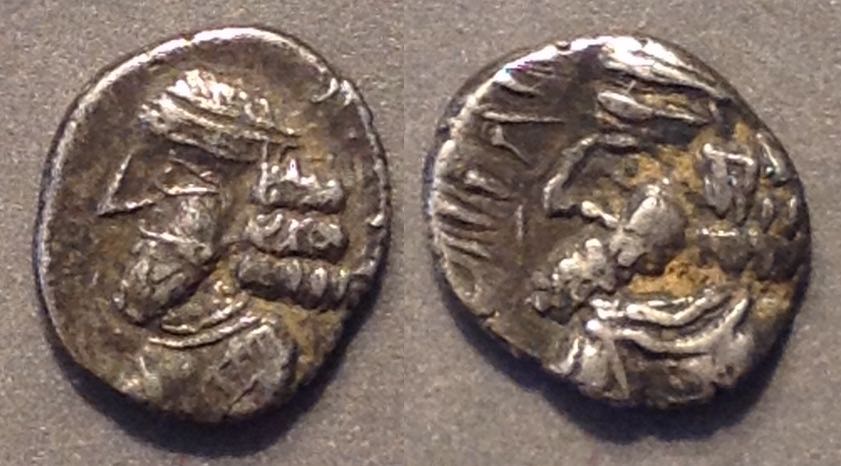
Pakor II. First half of the first century AD.
Obol. 8-7 mm. 0.52 grams. Thicker than the above obol.
vH 594
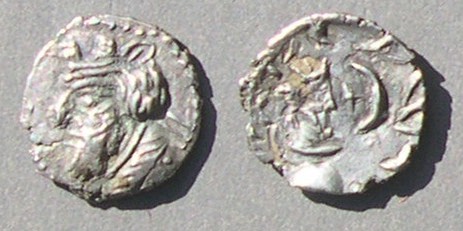
Nambed (Namopat). First century AD.
Obol. 10 mm. 0.56 grams.
vH 602 variety (bust facing crescent on reverse instead of standing figure)
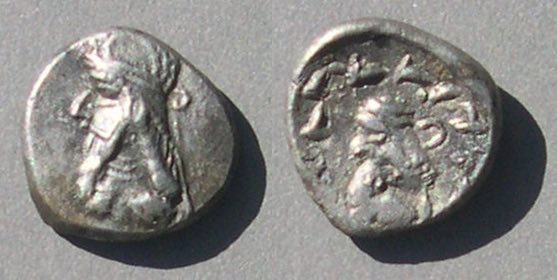
Nampad II (Kapat). First century AD.
Hemidrachm. 12 mm. 1.63 grams.
vH 613.5
Nampad II (Kapat). First century AD.
Obol. 10 mm. 0.61 grams.
vH 614.3
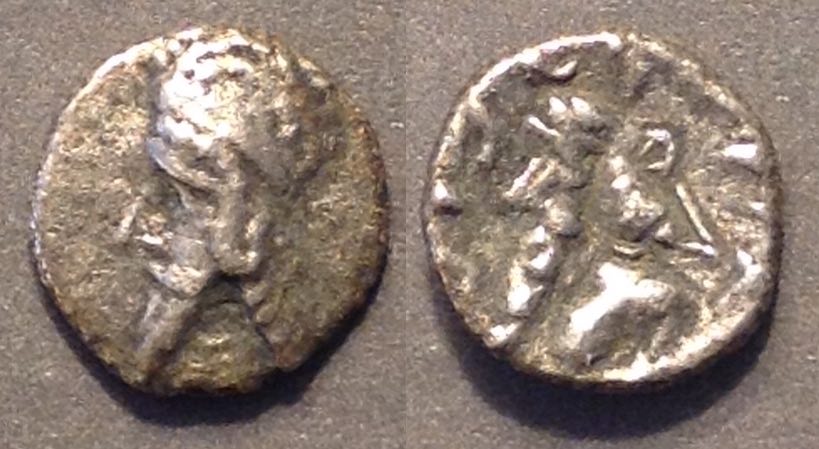
Nampad II (a .k.a. Kapat). First century AD.
Obol. 7 mm. 0.43 grams.
vH 614.4
The previous obverse had hair in three waves. This one has "hair falling to shoulder."
Usually that difference would be enough to attribute the coins to different kings, but apparently not in this case.
Uncertain Kings
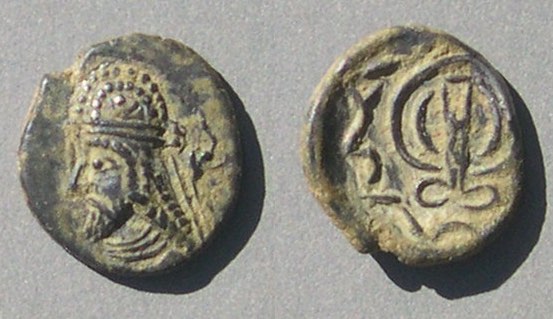
Uncertain King, a.k.a. Prince Y. First century AD.
Hemidrachm. 13-12 mm. 1.47 grams.
The reverse design is a diadem with wreath ties.
vH 619.1
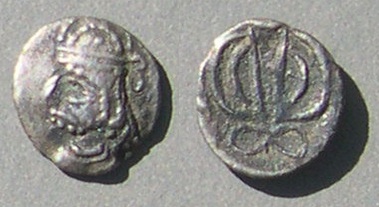
Uncertain King II, a.k.a. Prince Y. First century AD.
Hemiobol? Obol? 9 m. 0.36 grams.
vH 620.1
Alram 620 has it as on obol at this size.

Prince Z. First century AD.
Hemidrachm. 13 mm. 1.13 grams.
vH 621.2

Manchir (Manucithr I). First-second centuries AD.
Hemidrachm. 14 mm. 1.48 grams. Thicker than the above obol.
vH 627A

Ardaxsir III. (Artaxerxes III). First-second centuries AD.
Drachm. 17 mm. 2.23 grams (Smaller and lighter than earlier drachms).
vH 631
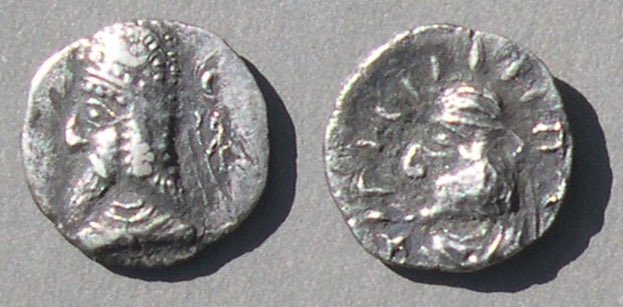 I am not sure about this one.
I am not sure about this one.
I will update its attribution when I hear from an expert.
Possibly Kaput, a.k.a. Nampad. First to second centuries AD.
Maybe Manchir I (vH 628?)
Hemidrachm. 15 mm. 1.45 grams.
Conclusion. This page illustrates common types issued in the middle period of the Kingdom of Persis. They are all silver. Almost all have uncertain dates. The latest reference, van't Haaff, is free in pdf form. (It is currently being revised for publication.) The earliest coinage of Persis includes large tetradrachms with impressive portraits, none of which are illustrated on this page. Coinage of Persis ends with types that almost look Sasanian, none of which are illustrated here. (When they expelled the Parthians, the ruler of Persis founded what we call the Sasanian empire.)
Kings and Dynasties. "Based on their coins 34 rulers have been identified, 25 with a name attributed to them. Müseler has divided the rulers into 5 Dynasties, with 2 or 3 periods when the Seleucids and later the Parthians ruled Persis directly and no Persis coins were struck" [vH page 17]. Here is his breakdown. (Not everyone agrees.)
* ± 280 - 220 BC Frataraka Dynasty with 4 rulers
* 220 - 190/164 BC No Persis coinage, direct Seleucid rule
* 190/164 - 140 BC Dynasty of Vādfradād II with 6 rulers
* 140 – 100 BC No Persis coinage, direct Parthian rule
* 100 BC–end1st cent AD No Persis coinage, direct Seleucid rule
* 100 BC–end1st cent AD Dynasty of Vādfradād IV with 13 rulers. Possible break in Persis coinage after Vahšīir
* Late 1st cent – 211 AD Dynasty of Vādfradād V with 9 rulers
* 211-224 Dynasty of Shāpur (Pābag) with 2 rulers
References: Since 1986 Alram has been the major reference, even though it lists fewer than half the known types. The 2020 pdf manuscript of van't Haaff is the new standard. It is a draft which is being revised and when it comes out it will have an entirely new numbering system.
vH = van't Haaff, P.A. 2020. Catalogue of Persis Coinage, Ca. 280 B.C. – A.D. 228. The manuscript is available for free in pdf from CNG. It is extremely well illustrated.
"In the catalogue 1423 coins are illustrated, attributed to 260 types and sub-types of which 140 are newly identified. 34 rulers belonging to 5 dynasties have been identified, 25 of whom have a name attributed to them. Nine have no or a meaningless legend and are not identified by name." [Page 1] Pages 2-3 discuss reattributions since Alram was published.
Alram = Alram, Michael, 1986. Iranisches Personennamenbuch, volume IV, in two volumes, one massive (12" x 16") in hardback with the text and one thin, but very large format (11"x16") with 47 page plates in B&W. This book lists and illustrates very many types from numerous ancient kingdoms, but it is far from complete for coin types of those regions; it covers only types with Iranian proper names.
Types of Persis are numbers 511-626. Lower numbers include coins of many other minor kindoms including the Kings of Pontus, the Bosporus, Bithynia, Lydian Satraps, Cappadocia, Sophene, Armenia, Kommagene, Parthia, Elymais, and Characene. Higher numbers include the Sasanian Kings, Kings of Tarbistan, and Kings of the region of Afghanistan and India with Iranian names.
Sear, David. 1982. Greek Imperial Coins. pp. 588-591, numbers 5935-5970, with 11 illustrated.
Go to the main Table of Contents page of this educational site.
 Ancient coins of Persis, a kingdom within Ancient Iran
Ancient coins of Persis, a kingdom within Ancient Iran When the Parthians (Arsacids) took Iran from the Seleukids c. 250 BC, Persis remained dependent, but was able to issue its own coins. The last ruler of Persis, Ardaxšir (Artaxerxes) V, overthrew the Parthian rulers (Arsacids) c. 224 AD and became the first king of what we now call the Sasanians and then issued new larger silver coin types. For Sasanian coinage he is called Ardaxšir I, a.k.a. Ardashir I (instead of Ardaxšir V of Persis).
When the Parthians (Arsacids) took Iran from the Seleukids c. 250 BC, Persis remained dependent, but was able to issue its own coins. The last ruler of Persis, Ardaxšir (Artaxerxes) V, overthrew the Parthian rulers (Arsacids) c. 224 AD and became the first king of what we now call the Sasanians and then issued new larger silver coin types. For Sasanian coinage he is called Ardaxšir I, a.k.a. Ardashir I (instead of Ardaxšir V of Persis).  Darayan (Darius I of Persis). End of second century BC.
Darayan (Darius I of Persis). End of second century BC.
















